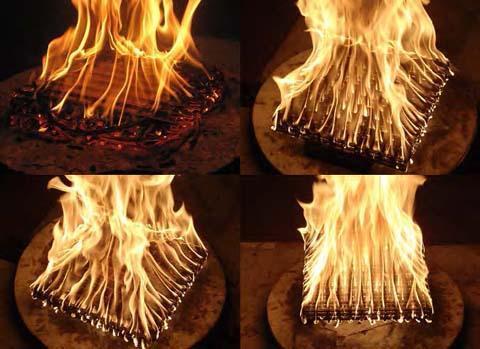Understanding Burning Rate and Residence Time of Porous Fuel Beds Using Wood Cribs
The fire spread process is fundamentally a series of ignitions, where a parcel of fuel ignites and burns at a particular rate, heating the neighboring fuel parcel until it subsequently ignites. The burning rate (and the associated heat release rate) of a fuel parcel or section of a fuel bed is therefore a critical piece of the fire spread process. However, current operational models don’t treat fire spread in this manner, and assume that the is already fire spreading and at a constant rate. To alleviate these assumptions and allow future models to predict accelerations, decelerations, and thresholds in fire spread (will it even spread at all?), new operational fire spread models will need to treat fire spread as a series of ignitions, incorporating understanding of the fuel bed burning rate. To capture thresholds for fire spread, knowledge of the flaming duration of a fuel bed, or the “flame resident time,” is required as well. If this flame residence time is less than the ignition time of the next fuel parcel, the fire won’t spread. Though the flame residence time is simply related to the amount of fuel present and the rate that it burns, no single theory exists for the prediction of flame residence time. Better understanding of flame residence time and burning rate of fuel structures will thus allow for better fire spread and fire effects predictions.
The burning rate and flame residence time of fuel structures are studied using ordered cross piles of sticks called cribs, commonly used in the fire protection engineering (structural fire) literature. Even though wildland fuels do not have the same predictable arrangement as cribs, wildland fuels are similar to cribs in that they are essentially individual fuel particles arranged with some spacing distance between them. Thus, the fundamental understanding of what governs the burning rate of a crib would apply to the wildland fire context.
Though cribs are used frequently in fire protection engineering as ignition sources for other materials, the relations developed to predict their burning rate were based on a relatively limited set of data from cube-shaped cribs. The first step of this research examined cribs with a wide variety of layouts and geometries to test whether these predictive relations were valid for fuel beds that are more applicable to the wildland context. The wildland context also includes many other fuel and environmental conditions not addressed in our current understanding of the mechanisms the govern the burning rate of porous fuel beds like cribs. Experiments are conducted to address these gaps which include:
- surface versus crown fuels (the gap between the weighing platform and the bottom of the crib),
- moisture content,
- wind,
- axisymmetric versus line fires, and
- the size of the fire itself.
For this last scenario, large fires likely burn differently than small fires because of the formation of tall and wide plumes above the fire, generating a form of fire-atmospheric interaction. This is explored experimentally in lab-based studies through the use of a chimney to mimic the fluid dynamic changes thought to occur in these large plumes. Cribs are built with different stick thicknesses, lengths, densities, and geometries to understand how the fuel bed structure and the environmental conditions listed above interact to affect the burning rate.
Key findings include:
- The more commonly used relations for the burning rate of wood cribs do not hold for wide fuels beds constructed of thin fuel elements. However, a relatively unknown relation found in the literature held for all fuel bed geometries tested (see McAllister, Sara; Finney, Mark. 2016. Burning rates of wood cribs with implications for wildland fires. Fire Technology. doi: 10.1007/s10694-015-0543-5).
- The burning rate of a particular fuel bed can dramatically change depending on whether it is directly on the ground (surface fuel) compared to the same fuel bed suspended in the air (crown fuel). This is because most of the air required from combustion enters the fuel bed from below, particularly for wider fuels beds and thin fuel elements.
- The moisture content doesn’t uniformly change the burning rate of all fuel beds. Moisture increases in some fuel beds result in a more dramatic reduction in burning rate than others. There are even some fuel beds that actually burn faster with minor additions of moisture than when they are dry!
- Because much of the required air for combustion enters from below, fuel beds suspended above the ground burn the same whether they are burned as an axisymmetric fire (where air can flow in from all sides) or as an element in a line fire (where air can only flow in from two sides). The same applies for surface fuel beds with larger fuel elements. Surface fuel beds with thin fuel elements don’t quite burn the same as line fire elements compared to the axisymmetric scenario.
- Fuel beds in large area fires can burn up to twice as fast as the same fuel bed burning as a small line fire. The reduced entrainment into the plume as the fire grows in area generates a fire-induced wind at the level of the fuel bed that greatly increases the burning rate. This fire-induced wind may also contribute to the transition between smoldering and flaming, resulting in larger consumption of fuel in the flaming front than would ordinarily occur.
